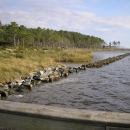About Us
Our Mission
Refuge Purposes
Each unit of the National Wildlife Refuge System is established to serve a statutory purpose that targets the conservation of native species dependent on its lands and waters. All activities on those acres are reviewed for compatibility with this statutory purpose.
The purpose of Currituck National Wildlife Refuge, as reflected in the legislation under which Congress authorized the refuge and the Service has acquired land, is to protect and conserve migratory birds and other wildlife resources through the protection of wetlands, in accordance with the following laws:
“...for use as an inviolate sanctuary, or for any other management purpose, for migratory birds...” 16 U.S.C. Sec. 664 (Migratory Bird Conservation Act of 1929)
“...for (1) incidental fish and wildlife-oriented recreational development, (2) the protection of natural resources, (3) the conservation of endangered species or threatened species...” 16 U.S.C. Sec 460k-1 (Refuge Recreation Act of 1962)
Vision
The Currituck National Wildlife Refuge will provide habitat for migratory birds and endangered species as an integral part of the National Wildlife Refuge System. The refuge will restore, enhance, and maintain the natural processes and diversity of the unique habitats of the mid-Atlantic barrier island ecosystem. The refuge will also provide opportunities for compatible wildlife-dependent recreation. The refuge will develop and maintain partnerships with other agencies and organizations to accomplish refuge goals and objectives.
Our History
The inhabitants of Currituck County at the time of European settlement were coastal Algonkians. These Algonkians were the southernmost extent of a tribe that inhabited the Atlantic Coast north to Canada. They settled along the sounds, estuaries, major rivers, and tributaries where they could conduct agriculture, fishing, shell fishing, hunting, and gathering close to the village. The Algonkians called the area “Coratank” which means “The Land of the Wild Goose.”
The governor of colonial North Carolina established Currituck County in 1670 from part of Albemarle County. It was one of the five original ports in North Carolina and one of the first counties. The county built the original courthouse in 1723 and established the town of Currituck Court House in 1755. The county shortened the name of the county seat to Currituck. The government built the Currituck Beach Lighthouse in Corolla in 1875 on the Outer Banks to provide warning of the coast to ships at sea.
The first attraction for settlement was the abundant fish and game, which gave the county a reputation as a 'Sportsmen’s Paradise.' In the early twentieth century, wealthy sportsmen established lavish hunting clubs in the county. These included the Swan Island Club in 1870; the Whalehead Club in Corolla in 1922; the Currituck Gunning and Fishing Club in 1923; the Monkey Island Hunt Club in 1931; and Joseph Knapp’s estate on Mackay Island in 1918. Joseph Knapp was a wealthy insurance businessman and philanthropist who contributed to and helped develop the education system in Currituck County. He also founded an organization known as More Game Birds in America, which later became Ducks Unlimited. The Knapp estate was located on land that is now the Mackay Island National Wildlife Refuge, where he experimented with wildlife management techniques.
Other Facilities in this Complex
The refuge is managed as part of the Coastal North Carolina National Wildlife Refuge Complex. A National Wildlife Refuge Complex is an administrative grouping of two or more refuges, wildlife management areas or other refuge conservation areas that are primarily managed from a central office location. Refuges are grouped into a complex structure because they occur in a similar ecological region, such as a watershed or specific habitat type, and have a related purpose and management needs.
There are 9 national wildlife refuges in the Coastal North Carolina National Wildlife Refuges Complex. The Project Leader for the Complex supervises the Refuge Managers who are responsible for managing these refuges. However, there are five distinct and separate administrative offices. Alligator River and Pea Island National Wildlife Refuges are administered from the Alligator River National Wildlife Refuge Headquarters in Manteo, NC. An administrative office at the Mackay Island National Wildlife Refuge Headquarters in Knotts Island, NC manages both Mackay Island and Currituck National Wildlife Refuges. An office at Mattamuskeet National Wildlife Refuge administers Mattamuskeet, Swanquarter, and Cedar Island National Wildlife Refuges. Pocosin Lakes National Wildlife Refuge, Roanoke River National Wildlife Refuge, Great Dismal Swamp National Wildlife Refuge, Back Bay National Wildlife Refuge, and Edenton National Fish Hatchery each have separate administrative offices.
All of the Coastal North Carolina National Wildlife Refuges, Great Dismal Swamp National Wildlife Refuge, Back Bay National Wildlife Refuge, and Edenton National Fish Hatchery are open to public visits for nature-based recreational enjoyment. Priority public uses are hunting, fishing, wildlife observation, wildlife photography, environmental education, and interpretation.




